Introduction
Static code analysis (SCA) is a powerful technique for maintaining code quality and ensuring the reliability and security of software applications. It involves scrutinizing source code without executing it, identifying potential bugs, security vulnerabilities, and areas that don't conform to coding standards. SCA is particularly valuable in industries like banking, where precision and reliability are non-negotiable.
M&T Bank, with its 165 years of experience, implemented SCA tools and Clean Code standards to enhance the performance and security of their software. By integrating SCA into their workflow, they minimized maintenance time and costs while guaranteeing efficiency, reliability, and security. The benefits of SCA extend beyond bug detection; it fosters a culture of quality, streamlines the development process, and provides insights for prioritizing system improvements.
SCA plays a crucial role in addressing security concerns and complying with industry regulations. It ensures that software is built right from the start, reducing the likelihood of defects progressing into later stages of development. Although SCA tools have limitations, such as false positives and the inability to detect runtime issues, they are invaluable for maintaining code quality, enhancing software security, and promoting a culture of excellence within development teams and organizations.
With a wide range of SCA tools available, such as SonarQube, ESLint, and PMD, developers have the means to enforce coding standards and improve the reliability and security of their codebase. By integrating SCA into the development process and staying current with new releases and best practices, developers can maximize the effectiveness of SCA and ensure the long-term success of their software projects.
What is Static Code Analysis?
Static Code Analysis (SCA) serves as a guardian of code quality, meticulously scrutinizing source code without the need for execution. This method is not only about finding immediate issues but is a strategic approach to prevent vulnerabilities and bugs from compromising the codebase. Understanding the importance of SCA can be illuminated by looking at M&T Bank's initiative. With over 165 years of experience, they faced the digital transformation of the banking sector head-on by enforcing Clean Code standards across their development teams. This ensured their program met the highest security and regulatory standards, a necessity in an industry where the cost of introducing problematic applications can be devastating. By integrating SCA into their workflow, M&T Bank aimed to minimize maintenance time and costs while guaranteeing efficiency, reliability, and security.
In an industry where a mere glitch in the program can lead to significant financial and reputational loss, resources like SCA become indispensable. They address a system's resilience, trustworthiness, and dependability. A clear understanding of these factors allows for the system to be optimally tailored to its operational environment, from the unit level of individual functions or classes to the entire codebase.
The Forrester Wave™ report of Q3 2023, recognizing Synopsys as a leader in the SAST market, underscores the growing need for SCA solutions that seamlessly integrate into developer workflows, enhance product security, and support DevSecOps processes. With the highest scores in Detection and high marks in Product security and DevSecOps workflows, Synopsys' Coverity® SAST solution exemplifies the current offering's strength in the field.
Lastly, the challenges faced when setting up environments like Laravel on Digital Ocean highlight the practical hurdles developers encounter. Tools like Larasail, designed to streamline server setup, further emphasize the need for solutions that simplify development processes, allowing teams to focus on quality and security.
Utilizing SCA is not merely a technical choice; it's a strategic decision for organizations like M&T Bank, ensuring that as they sail through the sea of digital transformation, their vessels are not only seaworthy but fortified against the storms of cyber threats and regulatory demands.
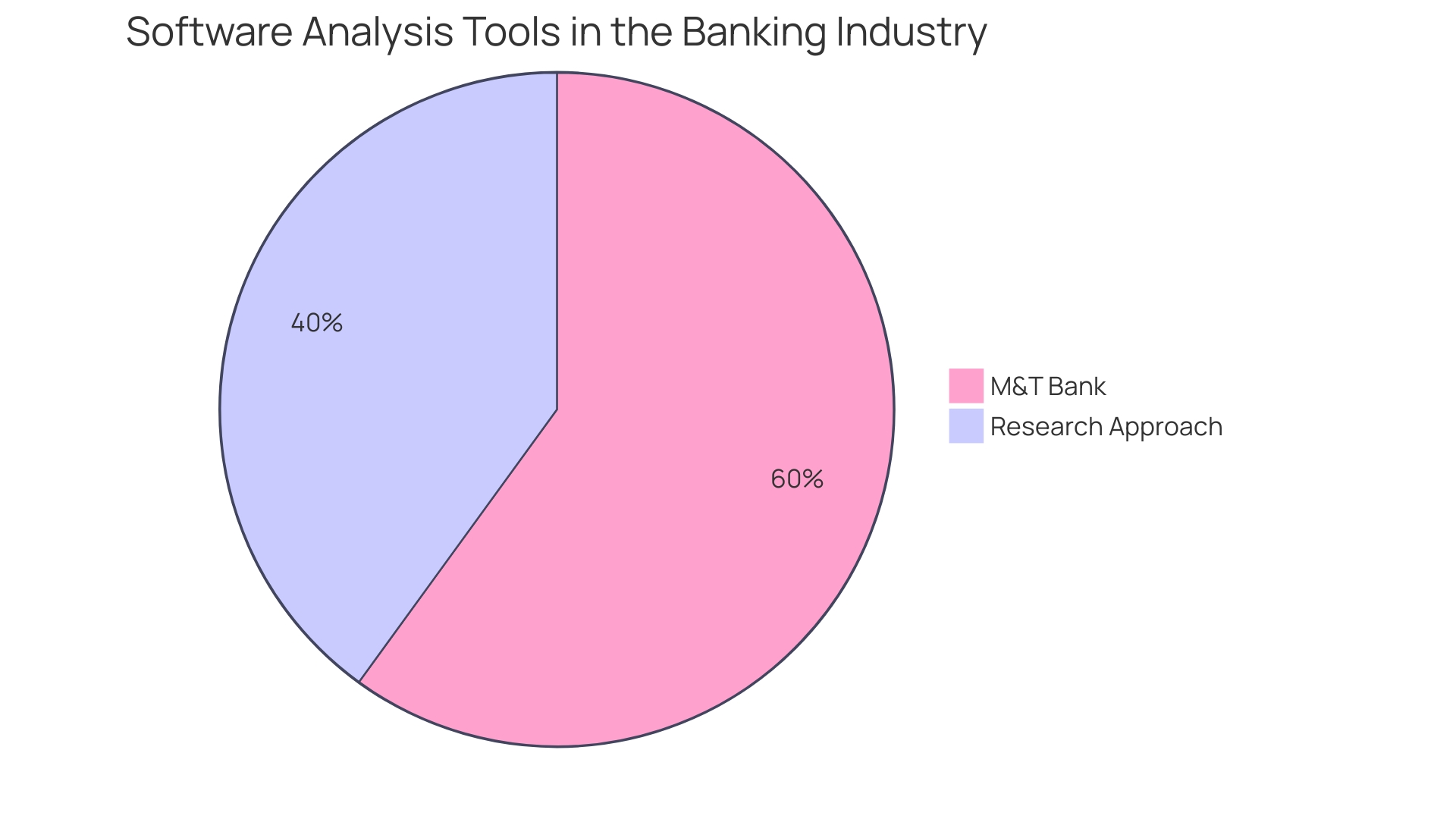
Benefits of Static Code Analysis
Static analysis is an essential tool for contemporary development, particularly in industries where accuracy and dependability are non-negotiable, like the banking sector. By systematically examining the source material prior to compilation, this practice supports developers in identifying bugs, security loopholes, and areas that don't conform to coding standards. It's a proactive strategy to enhance the quality of programming, which is crucial in preventing expensive mistakes and guaranteeing the resilience and adherence of the system.
For example, M&T Bank, an establishment with over 165 years of history, encountered the challenge of maintaining high-quality standards for their programming in an era of digital transformation. By implementing Clean Code guidelines and utilizing static analysis tools, their aim was to enhance the maintainability and performance of their software, thereby ensuring efficiency, reliability, and security.
Moreover, with the rise of AI and the widespread use of development tools, platforms like GitHub have become essential to the development lifecycle. They offer insights that assist in optimizing the development process, providing metrics to assess quality of the software and its influence on aspects such as time-to-market and customer satisfaction. This data-driven approach aids in prioritizing system improvements, communicating the cost-benefit of quality trade-offs, and pinpointing high-risk application areas for targeted enhancement efforts.
In the realm of verification and validation, static examination serves as a proactive verification measure. It ensures that the product is being built right from the start, aligning with the specified requirements and design. As a result, the likelihood of defects progressing into later stages of development is significantly reduced, saving time and resources.
Additionally, the thorough reporting capabilities of contemporary static programming examination tools offer extensive understanding into the risk panorama, allowing teams to prioritize fixing vital concerns initially. This strategic prioritization is vital for maintaining an all-digital customer experience that meets the highest level of security and regulatory standards.
As software development continues to evolve, static analysis remains a cornerstone of quality assurance. It's not just about writing software; it's about crafting a solution that stands the test of time and serves its purpose without fail, particularly in industries where the stakes are high.
Types of Static Code Analysis
Static Code Analysis (SCA) presents a suite of methods that analyze source code for potential issues without executing the program. These techniques serve as a preventative measure, much like detectives on the lookout for the most elusive bugs. They point out errors like the typos found in the OpenVINO project, which are unavoidable in a developer's profession. By identifying common patterns where mistakes occur, developers can significantly reduce these errors.
Among the SCA techniques, Security Analysis is crucial for pinpointing vulnerabilities that might compromise a system's integrity. It's a process that, despite the high quality of the OpenVINO project, proved to be beneficial. In fact, it was found that even established projects can gain from a good static analyzer, underscoring the importance of static code analysis in maintaining and improving software security.
Performance Analysis is another type of SCA that delves into efficiency, aiming to enhance performance and resource management. By understanding the broader aspects of a system's quality, such as trustworthiness, dependability, and resilience, this analysis helps tailor software behavior to its operating environment.
Code Formatting Analysis ensures uniformity across the codebase, enforcing standardized conventions. As Ward Cunningham wisely observed, the expeditiousness of shipping initial software can lead to technical debt, which should be promptly resolved through refactoring to avoid impeding development.
SCA tools are not only essential for maintaining a high-quality codebase but also play a significant role in fostering a culture of quality within teams and organizations. By incorporating these resources into the workflow, developers and organizations can efficiently handle the quality of their systems at every level, from a single unit of programming to the entire codebase.
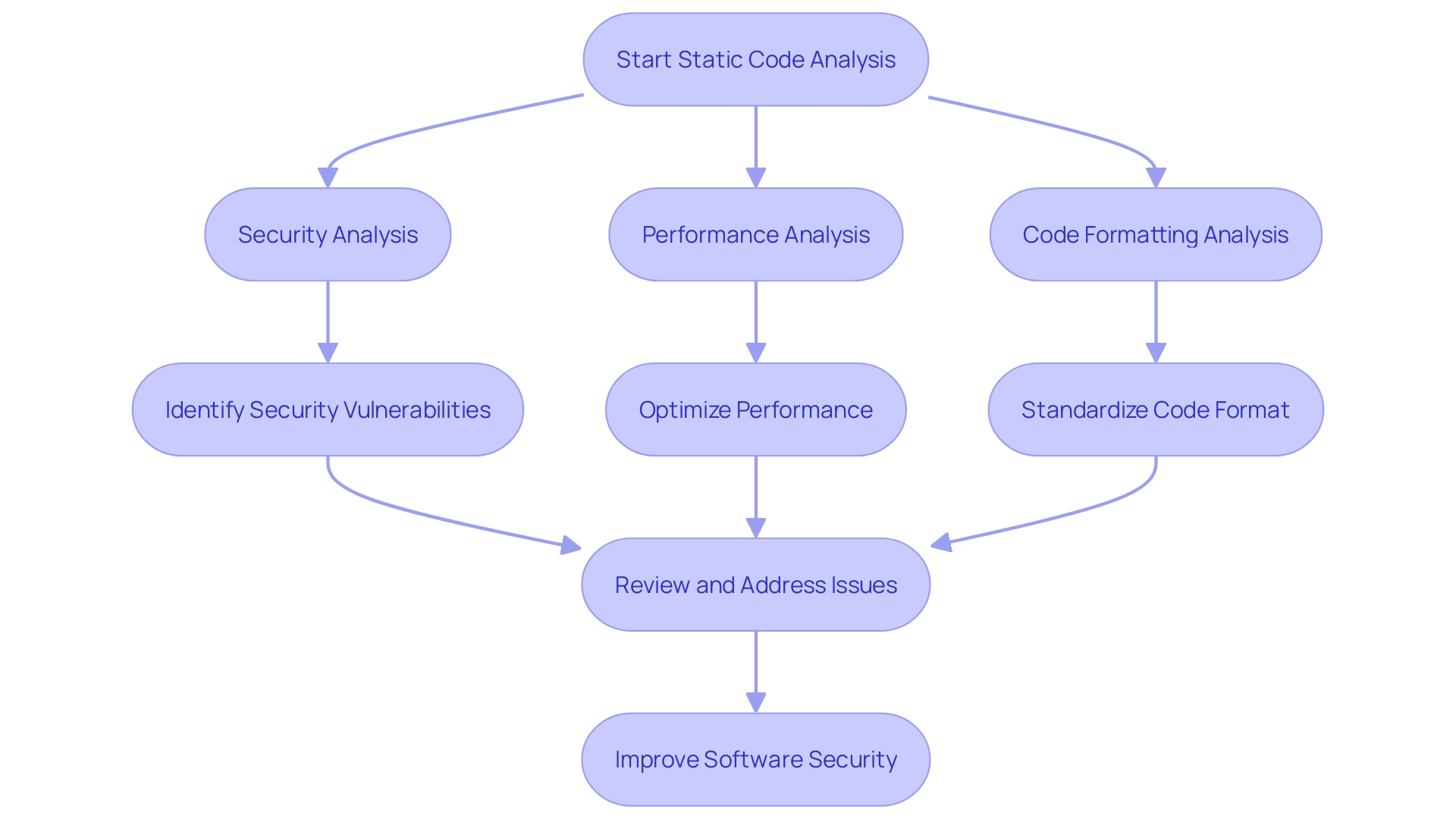
How Static Code Analysis is Done
Static analysis (SCA) is similar to an automated review process. It employs advanced mechanisms that examine the source code without running it, searching for potential issues such as coding errors, security vulnerabilities, and regions that might impede performance. By utilizing a blend of algorithms and predetermined guidelines, these resources can identify areas for enhancement, enabling developers to rectify problems early in the development lifecycle. This process can be seamlessly integrated into the development environment or employed as an independent review step, enhancing the quality and reliability of the final software product.
In practice, SCA mechanisms function as watchful bug finders, uncovering hard-to-find errors and highlighting the type of mistakes that are bound to occur in a developer's work. These instruments not only detect mistakes but can also offer statistics on common blunders, making typo management more efficient. By analyzing code at the unit level, examining individual functions or classes, SCA tools make a significant contribution to the overall quality of a system by ensuring each component is robust and reliable.
The usefulness of SCA extends to established projects as well, not just new developments. For instance, in an examination of the OpenVINO project, a static analyzer revealed enlightening typos and errors that, although not numerous, were meaningful enough to warrant discussion over several articles. This highlights the role of SCA in promoting best practices and enhancing the quality culture within development teams, regardless of project size or maturity.
Empirical studies support the importance of SCA, providing recommendations to assist developers and researchers in choosing the appropriate static examination tools for their projects. These guidelines are pivotal in driving the advancement of software analysis instruments, thereby contributing to the enhancement of software systems and the development process as a whole. The insights obtained from these studies outline the strengths and weaknesses of various SCA tools across different programming languages, providing a clearer understanding for those invested in development.
Real-World Examples of Static Code Analysis
The field of development is swiftly evolving, with industries like banking undergoing notable digital changes. M&T Bank, a long-standing institution, tackled these shifts head-on by setting Clean Code standards across its organization, aiming to maintain the performance of its systems. They acknowledged the crucial requirement for applications that not just fulfills quality standards but also complies with strict security procedures to protect sensitive information, emphasizing the significance of examining the structure of static programming in modern software engineering.
Meanwhile, the surge in Jenkins' use, an open-source automation server, underscores the gravity of potential security flaws. With its extensive market presence, Jenkins' vulnerabilities could have widespread implications, demonstrating how static software examination is critical for identifying and mitigating risks in widely adopted tools.
In the battle against financial crimes such as money laundering, advanced technology utilizing sophisticated algorithms has emerged, capable of examining intricate transaction networks more effectively than conventional methods. This innovation represents another field where static program examination can have a crucial part in ensuring application integrity and reliability.
Furthermore, the integration of 3D scanning with CAD models for pipeline assembly by researchers from the University of Edinburgh showcases a proactive quality control approach. By implementing static program evaluation early in the development process, comparable proactive approaches can be utilized to detect issues before they worsen, conserving time and resources in projects as a whole.
Static examination of programming stands as a foundational method in preserving and improving quality. With the guidance of experts like Tom McCabe Jr., who suggests maintaining the CYC metric value below 10 for simplicity, developers can navigate the intricacy of programming more effectively. The adoption of static programming examination instruments, as recommended by scholars like Jones Yeboah, is thus crucial for developers and researchers alike to select the right instruments for error detection and to continuously improve the instruments for the advancement of computer systems.
Enhancing Security with Static Code Analysis
Static examination of the program is an essential method for maintaining integrity, especially in industries where security and compliance are paramount. Consider the banking sector, a prime example of where the highest security standards are not just expected but required. M&T Bank, with its 165 years of history, has faced the challenges brought on by the digital revolution, understanding the need to uphold stringent regulatory requirements to safeguard sensitive data and transactions. Static software examination tools have been pivotal in aiding M&T Bank establish and enforce Clean Code standards across its organization. This has been crucial in minimizing maintenance time, reducing costs, and ensuring the software's efficiency, reliability, and security.
The importance of examining the static programming instructions is further emphasized by the insights of Microsoft's One Engineering System team. Many developers experience frustrations when using tools not optimized for security reviews, which impedes their ability to pinpoint and rectify security issues such as SQL injection, cross-site scripting, and buffer overflows. By implementing static software examination early in the Software Development Life Cycle (SDLC), developers can proactively tackle weaknesses, improving the security of the applications they construct.
The significant influence of static code evaluation on application security is evident in the industry's approach to development. Advanced static application security solutions are capable of extensive vulnerability coverage, providing broad language and framework support. This thorough examination ensures that no part of the codebase is overlooked, thereby identifying a wide range of potential vulnerabilities.
As the technological environment develops, so do the challenges and tools to uphold security. Studies have demonstrated the significance of comprehending the underlying factors and features of problems that provoke inaccurate results in static software evaluation. Uninterrupted innovation in this domain promises to further refine the techniques and reduce the costs associated with maintaining the highest standards of engineering security.
Essentially, static analysis is not merely a tool but a fundamental practice for ensuring that applications remain secure, efficient, and trustworthy in an era where digital threats are becoming increasingly sophisticated and pervasive.
Improving Code Quality and Efficiency
Static Code Analysis (SCA) plays a crucial role in improving the quality of programs by identifying coding issues, potential bugs, and areas of inefficiency within the codebase. It ensures a uniform coding guideline, which is essential for upholding the quality of the program, particularly in intricate sectors such as banking. For example, M&T Bank, with its rich heritage and extensive operations, encountered the task of maintaining clean programming standards to guarantee the dependability and efficiency of its applications during a digital revolution. The banking sector's shift to an all-digital experience introduces rigorous security and regulatory demands, making flawless software a necessity to avoid the high costs, time investments, and risks associated with deploying problematic applications.
To maintain a competitive edge and manage the high stakes of sensitive data protection, banks like M&T must uphold stringent quality metrics. Complexity metrics, such as the Cyclomatic Complexity (CYC) score, provide a quantifiable measure of program maintainability. A CYC score above 10 indicates the need for simplification to prevent the introduction of errors and maintain testability. In addition, incorporating the most recent SCA solutions, such as MSBuild Structured Log Viewer created by Kirill Osenkov from Microsoft, is crucial for immediate examination and reporting throughout the compilation procedure, improving the developers' capacity to generate error-free software.
SCA not only supports compliance with industry regulations but also aligns with the broader aspects of system quality. It deals with different levels of system examination, from separate units of programming to the complete application, guaranteeing that the software stays reliable, trustworthy, and resilient. By focusing on SCA, organizations can minimize maintenance time, reduce associated costs, and prioritize improvements that significantly impact time-to-market, customer satisfaction, and risk management.
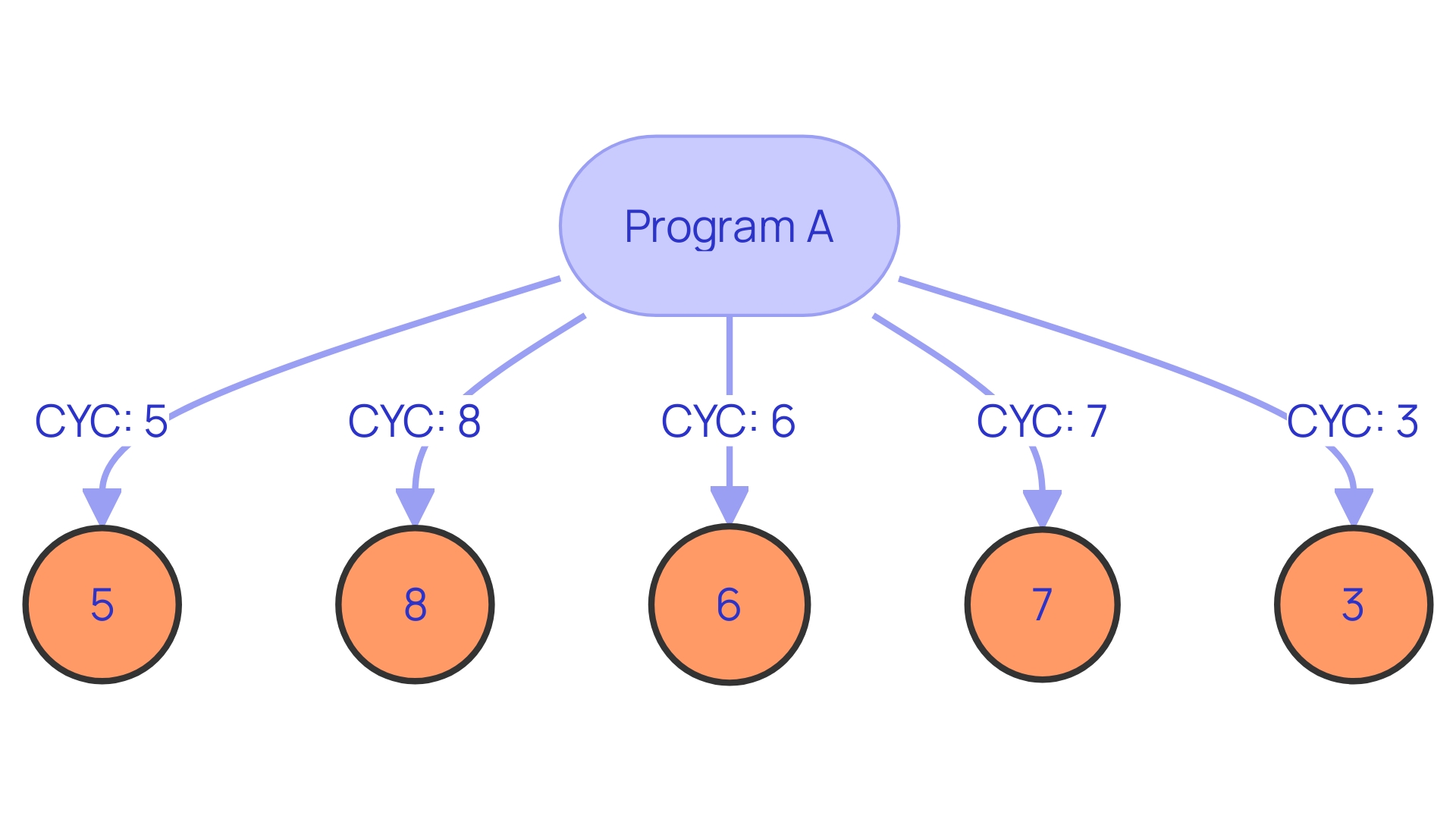
Common Issues Detected by Static Code Analysis
Static software examination is a potent instrument for identifying a variety of prevalent coding problems that can afflict even the most experienced programmers. It serves as a vigilant watchdog, uncovering problems such as null pointer dereferences, memory leaks, and buffer overflows that can lead to application crashes or security breaches. By carefully scanning the source code for uninitialized variables, static analysis prevents unpredictable behavior at runtime, while also identifying unused or redundant portions of the program, thus contributing to cleaner, more efficient codebases. Furthermore, it plays a critical role in identifying inefficient algorithms that can slow down applications, and it ensures programming formatting is consistent, which is crucial for maintainability.
In a study involving PMD, SpotBugs, and SonarQube, three popular static analyzers, researchers conducted a systematic review of 350 historical issues related to false negatives (FNS) and false positives (FPs). This study not only addressed the root causes and characteristics of these issues but also led to the discovery of new strategies to mitigate FNS and FPs. For instance, a planned metamorphic testing approach revealed 14 new problems, with developers verifying and addressing 11, showcasing ongoing enhancement in static evaluation tools.
The advantages of examining the structure of a program are not restricted to discovering spelling mistakes or basic flaws; it provides understanding into more intricate and nuanced programming problems. A practical demonstration of this can be observed through the examination of the Intel OpenVINO project, where static examination provided valuable statistics to assist in addressing common mistakes. Furthermore, the promotion of static programming analyzers is not to undermine programmers' efforts but to highlight their importance in enhancing the quality of even high-profile projects, with free licenses available for open-source developments.
The incorporation of static program evaluation into the development process is an essential stride towards promoting a culture of excellence within teams and organizations. It's crucial to grasp the different quality measurements of a system, such as trustworthiness, dependability, and resilience, and how static analysis tools can impact these factors. By analyzing problems from unit level to system level, developers can customize their applications to function optimally within its intended environment.
Recent trends highlight the significance of understanding the contents of your software, with the 2024 Open Source Security and Risk Analysis report emphasizing the growing dependence on open source and AI-generated programming. The average application now contains 526 open source components, making manual testing impractical and automated solutions like software composition analysis indispensable for security testing at scale.
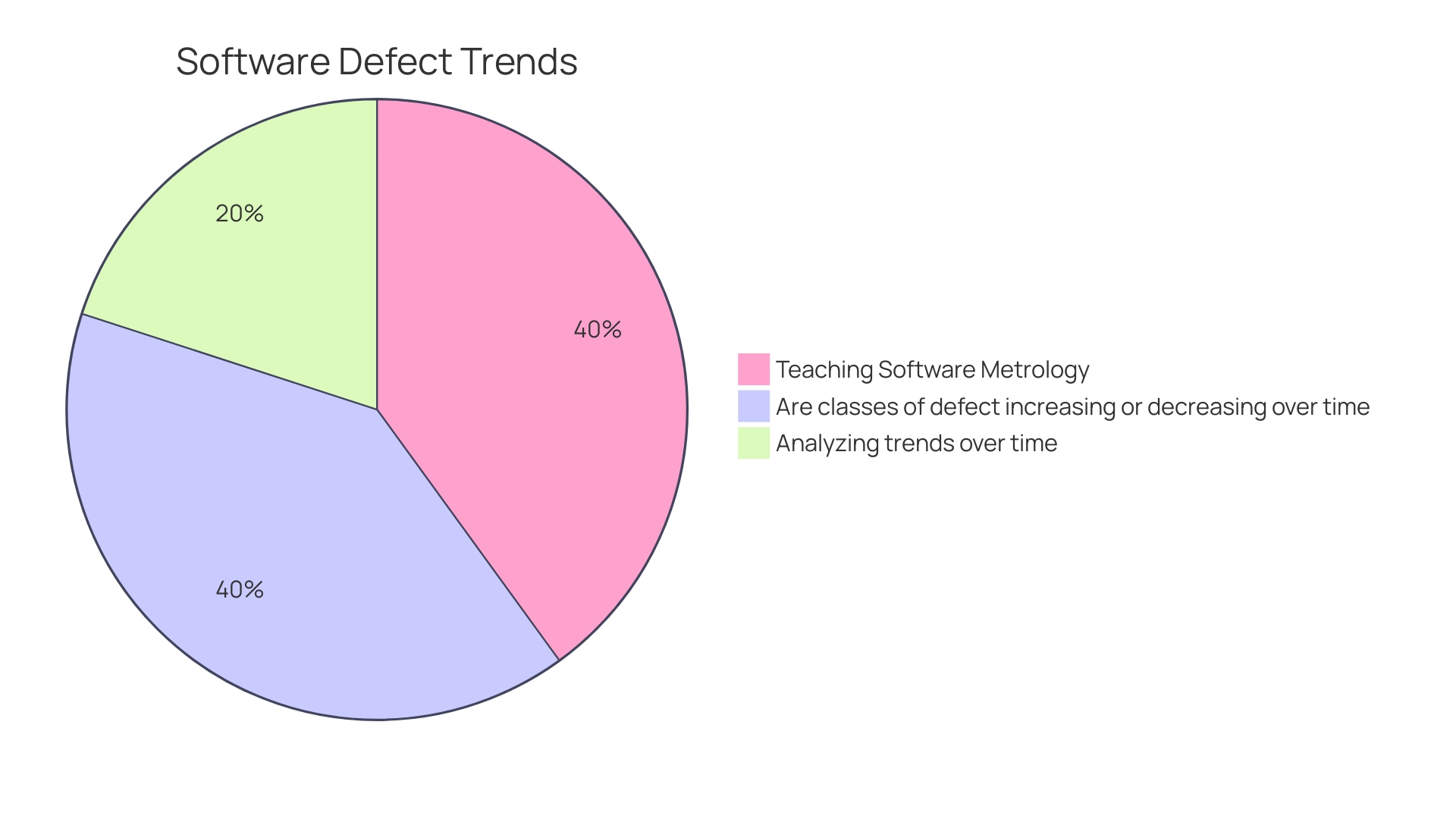
Challenges and Limitations of Static Code Analysis
Static Code Analysis (SCA) instruments play a vital role in enhancing the quality of the program, but they are not devoid of their idiosyncrasies and difficulties. One common issue is the occurrence of false positives, which can mistakenly flag well-functioning software as problematic, leading to unnecessary debugging efforts. Moreover, these instruments are restricted to examining the stationary facets of code, signifying they're not equipped to detect issues that arise solely during runtime, potentially leaving some glitches undetected.
Moreover, the intricacies of large codebases add an additional layer of complexity, as scanning them thoroughly can be a hefty task, both in terms of time and computation resources. For instance, during the development of Datadog's static analyzer, the team faced a challenge with resource-restricted continuous integration (CI) environments. They noted that scanning medium-sized repositories ideally should take under three minutes, but on a GitHub Actions runner with modest specifications, it took significantly longer.
Setting up and fine-tuning SCA tools is another hurdle, requiring initial effort and know-how. As highlighted by the experience shared in a blog post detailing the journey of migrating from Java to Rust, finding the right balance between control and performance is crucial. In the case of Datadog, granting customers more control over the analysis process improved both security and performance, albeit with some trade-offs in CI environments.
Besides these insights, the most recent development news highlights the effectiveness of caller info attributes in C#, like CallerMemberName, CallerFilePath, and CallerLineNumber. These attributes are particularly beneficial for logging, debugging, or tracing, and demonstrate the evolving landscape of tools and features designed to assist developers in creating robust software.
Ultimately, integrating SCA into your development workflow requires a nuanced understanding of its impact on the overall quality culture within your team. As articulated by industry experts, a good performance evaluation not only quantifies a system's behavior but also sheds light on its internal mechanisms, offering clarity on system limitations and areas for improvement. This deep understanding is essential for maintaining high performance over the lifespan of a product.
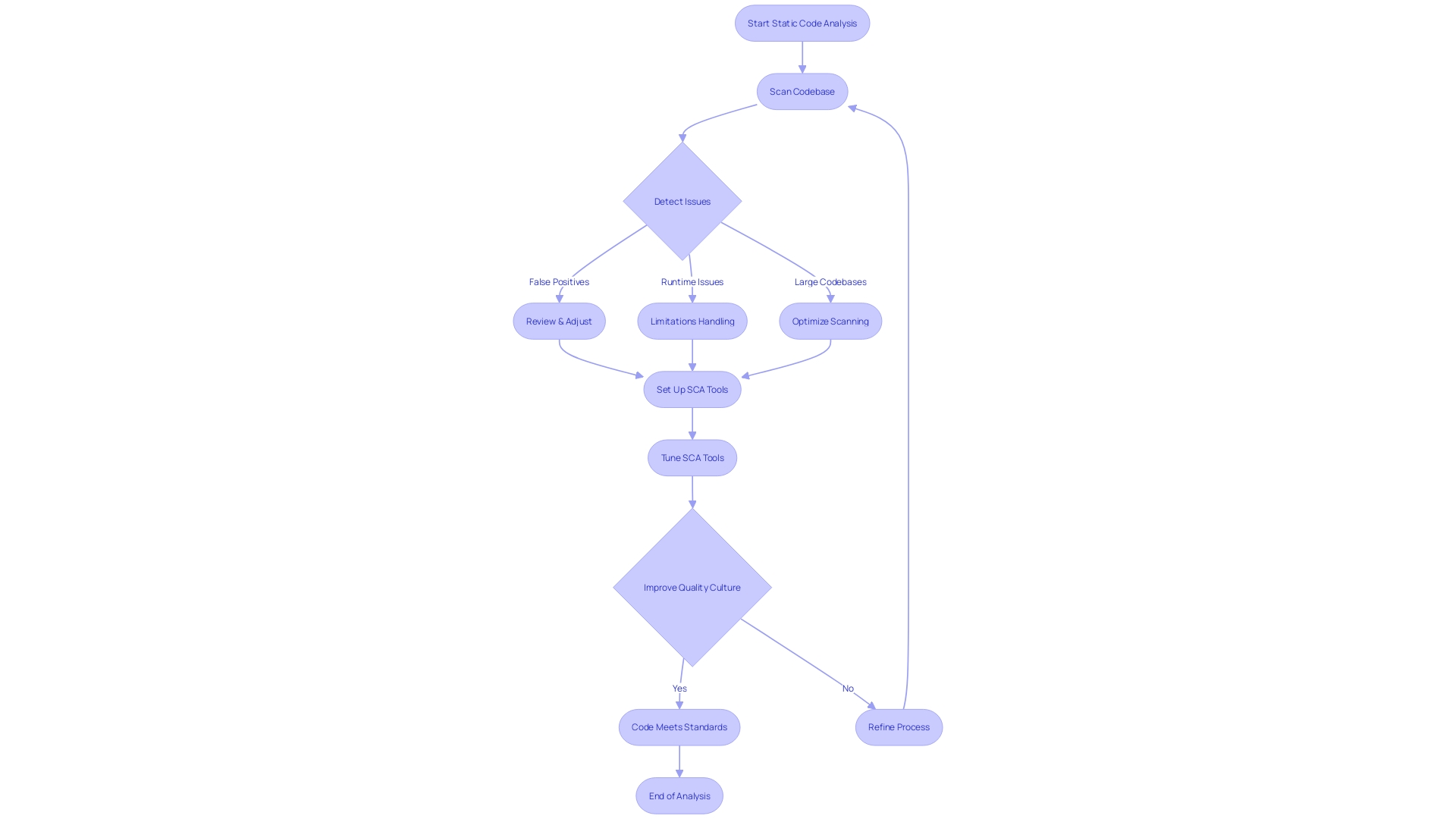
Best Practices for Implementing Static Code Analysis
Static Code Analysis (SCA) is an essential practice for maintaining code quality and reliability. To maximize its effectiveness, integration into the development process is critical. By embedding SCA into the build process or development environment, developers can identify issues at the earliest stages, reducing the risk of costly and time-consuming fixes later on.
Customization of rule sets to fit specific coding standards and requirements is another cornerstone of best practices. This allows for customized examination that aligns with organizational goals and coding conventions. Moreover, staying current with new releases of SCA tools and periodically reviewing the results of analyses ensures that the tools remain effective and relevant.
Promptly addressing identified issues is paramount. Acting swiftly not only maintains code quality but also prevents potential security breaches and compliance issues that could lead to financial losses or reputational damage. For instance, M&T Bank, with its 165-year history of innovation, has recognized the need to establish Clean Code standards organization-wide to maintain maintainability and performance of programs.
As we see the rapid digital transformation in industries such as banking, where stringent security and regulatory demands are non-negotiable, the adoption of new technologies must be accompanied by robust SCA practices. This not only reduces application maintenance time and expenses but also guarantees efficiency, reliability, and security of the program.
In summary, the top approaches for SCA are not only related to incorporating and tailoring solutions but also to instilling a culture of excellence within the team and the organization. This approach is supported by recent developments such as the beta release of TypeScript 4.9, which reflects an ongoing commitment to enhancing language safety and developer productivity.
With guidance from industry experts such as Dennis Dietrich, who possesses more than two decades of expertise and a strong enthusiasm for software development, we are reminded that the process of incorporating SCA tools into our workflow is equally influenced by the mentality and quality culture that we cultivate within our organizations.
Tools for Static Code Analysis
There are numerous Static Code Analysis (SCA) tools available to developers, each offering distinctive features to improve quality and compliance. Among these, SonarQube stands out as an open-source platform that assesses software for potential errors, vulnerabilities, and adherence to coding standards. With its extensive analysis capabilities, SonarQube offers developers insights to enhance the security and maintainability of the software, which is particularly crucial in industries with strict regulatory requirements, such as banking.
For instance, M&T Bank, with its long-standing commitment to community-focused banking, has faced the challenges of digital transformation head-on. The bank has adopted resources such as SonarQube to guarantee the tidiness and adherence of its programming, which is essential for upholding trust and security in the financial industry. SonarQube's versatility across various programming languages makes it an invaluable asset for developers working in diverse environments.
In addition to SonarQube, ESLint, PMD, Checkstyle, FindBugs, Fortify, Coverity, ReSharper, and Klocwork offer developers a range of options to suit their specific needs. By incorporating these tools into their workflow, teams can guarantee quality from the unit level up, ultimately contributing to a culture of excellence within the organization.
The significance of clean programming, defined by readability and simplicity, cannot be emphasized enough. Descriptive naming conventions and avoidance of unnecessary complexity are key practices for writing code that not only functions correctly but is also easily understood and reusable by other developers. This focus on clarity and maintainability is essential for building resilient software systems that can adapt optimally to their operating environments.
With the latest information and updates from the developer community, such as best practices and technical guides, developers are empowered to make security their top priority. Whether it's through free virtual events or monthly newsletters, access to these resources helps developers stay informed and adopt the best SCA tools for their projects. Tools like SafeLine further exemplify the drive towards automated security auditing and code security awareness, offering features like multi-language support and intuitive user interfaces to accommodate developers at all levels.
Conclusion
In conclusion, integrating static code analysis (SCA) into the development workflow offers numerous benefits for maintaining code quality, enhancing software security, and promoting a culture of excellence. M&T Bank's implementation of SCA tools and Clean Code standards is a prime example of its effectiveness in minimizing maintenance time and costs while ensuring efficiency, reliability, and security.
SCA not only detects bugs but also fosters a proactive approach to prevent vulnerabilities and ensure compliance with coding standards. It plays a crucial role in addressing security concerns and complying with industry regulations. While SCA tools have limitations, they are invaluable for maintaining code quality, enhancing software security, and promoting a culture of excellence within development teams and organizations.
Developers have a wide range of SCA tools available, such as SonarQube, ESLint, and PMD, to enforce coding standards and improve the reliability and security of their codebase. By integrating SCA into the development process and staying current with new releases and best practices, developers can maximize its effectiveness and ensure the long-term success of their software projects.
In summary, integrating SCA into the development workflow offers significant benefits in terms of code quality, software security, and overall efficiency. M&T Bank's implementation serves as a testament to its effectiveness in minimizing maintenance time and costs while ensuring reliability and security. SCA plays a crucial role in addressing security concerns and complying with industry regulations.
Despite its limitations, SCA tools are invaluable for maintaining code quality and promoting a culture of excellence within development teams and organizations. By utilizing a wide range of SCA tools and staying current with best practices, developers can enhance the reliability and security of their codebase and ensure the long-term success of their software projects.
Frequently Asked Questions
What is Static Code Analysis (SCA)?
Static Code Analysis is an automated process that examines source code for potential issues such as bugs, vulnerabilities, and non-conformance to coding standards without executing the program. It's a preventative measure that aims to ensure code quality and security.
Why is Static Code Analysis important in software development?
SCA is important because it helps to identify and fix issues early in the development process, preventing vulnerabilities and bugs from compromising the codebase. It is crucial for maintaining high security and regulatory standards, especially in industries such as banking where the cost of errors can be significant.
How did M&T Bank utilize Static Code Analysis?
M&T Bank integrated SCA into their workflow to enforce Clean Code standards, minimize maintenance time and costs, and ensure their software met the highest security and regulatory standards as part of their digital transformation initiative.
What kinds of problems can Static Code Analysis detect?
SCA can detect a variety of coding issues, including security vulnerabilities like SQL injection and cross-site scripting, potential bugs like null pointer dereferences, memory leaks, buffer overflows, and areas of inefficiency like unused variables and inefficient algorithms.
Are there different types of Static Code Analysis?
Yes, there are various types, including Security Analysis, Performance Analysis, and Code Formatting Analysis. Each type focuses on different aspects of the code to ensure it's secure, efficient, and adheres to standardized conventions.
How is Static Code Analysis performed?
SCA is performed using automated tools that scan the source code using a combination of algorithms and guidelines to identify potential issues. These tools can be integrated into the development environment or used as a standalone step in the development process.
Can existing projects benefit from Static Code Analysis?
Yes, SCA is useful for both new developments and established projects, as it helps to maintain code quality and security throughout the software lifecycle.
What are the benefits of Static Code Analysis?
The benefits include early detection of errors, improved maintainability, compliance with coding standards, enhanced performance, and strengthened security. It also aids in the prevention of costly mistakes and ensures the resilience of the system.
What are some common challenges and limitations of Static Code Analysis?
Common challenges include dealing with false positives, the inability to detect runtime issues, the complexity of scanning large codebases, and the effort required to set up and fine-tune SCA tools.
How can Static Code Analysis improve code quality and efficiency?
SCA improves code quality by enforcing uniform coding guidelines and identifying issues that could lead to bugs or inefficiencies. It helps in maintaining a high standard of programming, which is particularly important in complex sectors like banking.
What are some best practices for implementing Static Code Analysis?
Best practices include integrating SCA into the build process or development environment, customizing rule sets to fit coding standards, staying updated with tool releases, reviewing analysis results, and promptly addressing identified issues.
What tools are available for Static Code Analysis?
There are numerous tools such as SonarQube, ESLint, PMD, Checkstyle, FindBugs, Fortify, Coverity, ReSharper, and Klocwork. Each tool offers different features to address various aspects of code quality and compliance.




